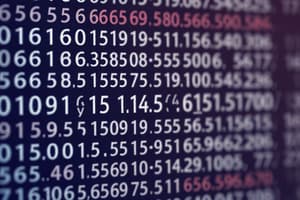Podcast
Questions and Answers
Which of the following statements is NOT accurate regarding Python's float data type?
Which of the following statements is NOT accurate regarding Python's float data type?
- Floats are stored using double precision.
- Floats have unlimited precision due to Python's dynamic typing. (correct)
- Floats are used to represent real numbers with decimal points.
- Floats are subject to limitations in precision because of how they are stored in memory.
Which of the following data types is immutable in Python?
Which of the following data types is immutable in Python?
- List
- Set
- Tuple
- Dictionary
Given my_dict = {1: 'a', 'b': 2}, which of the following operations will result in an error?
Given my_dict = {1: 'a', 'b': 2}, which of the following operations will result in an error?
- `my_dict['b']`
- `my_dict[(1,2)] = 'c'` (correct)
- `my_dict[1]`
- `my_dict[3] = 'c'`
Which data type is most suitable for storing a sequence of unique, unordered elements?
Which data type is most suitable for storing a sequence of unique, unordered elements?
What will be the result of the expression 5 // 2 in Python?
What will be the result of the expression 5 // 2 in Python?
Which of the following is the correct way to represent a complex number in Python?
Which of the following is the correct way to represent a complex number in Python?
If you have a string s = 'hello' and want to extract the substring 'ell', which slicing operation would you use?
If you have a string s = 'hello' and want to extract the substring 'ell', which slicing operation would you use?
What is the primary difference between lists and tuples in Python?
What is the primary difference between lists and tuples in Python?
Which of the following represents a dictionary that maps student names to their corresponding grades?
Which of the following represents a dictionary that maps student names to their corresponding grades?
What is the purpose of the None type in Python?
What is the purpose of the None type in Python?
Which function is used to convert a value to a floating-point number?
Which function is used to convert a value to a floating-point number?
What is the result of the expression 10 % 3?
What is the result of the expression 10 % 3?
Given the list my_list = [1, 2, 3], how do you add the element 4 to the end of the list?
Given the list my_list = [1, 2, 3], how do you add the element 4 to the end of the list?
Which of the following comparison operators checks if two values are NOT equal?
Which of the following comparison operators checks if two values are NOT equal?
What boolean value will the expression bool(0) return?
What boolean value will the expression bool(0) return?
Which of the following operations is NOT supported for strings in Python?
Which of the following operations is NOT supported for strings in Python?
What happens if you try to access a key in a dictionary that does not exist?
What happens if you try to access a key in a dictionary that does not exist?
How would you create an empty dictionary in Python?
How would you create an empty dictionary in Python?
What is the data type of the expression [1, 2] + (3, 4)?
What is the data type of the expression [1, 2] + (3, 4)?
Given the code x = 5, what would be the value of x after executing x **= 2?
Given the code x = 5, what would be the value of x after executing x **= 2?
Flashcards
What is Python?
What is Python?
A high-level, interpreted, general-purpose programming language that emphasizes code readability through significant indentation.
What are Integers (int)?
What are Integers (int)?
Represents whole numbers (positive or negative) without any decimal points.
What are Floating-Point Numbers (float)?
What are Floating-Point Numbers (float)?
Represent real numbers with decimal points, using double precision.
What are Complex Numbers (complex)?
What are Complex Numbers (complex)?
Signup and view all the flashcards
What are Sequences?
What are Sequences?
Signup and view all the flashcards
What are Lists (list)?
What are Lists (list)?
Signup and view all the flashcards
What are Tuples (tuple)?
What are Tuples (tuple)?
Signup and view all the flashcards
what are Strings (str)?
what are Strings (str)?
Signup and view all the flashcards
What are Mappings?
What are Mappings?
Signup and view all the flashcards
What are Dictionaries (dict)?
What are Dictionaries (dict)?
Signup and view all the flashcards
What is the Boolean Type (bool)?
What is the Boolean Type (bool)?
Signup and view all the flashcards
What is the None Type (NoneType)?
What is the None Type (NoneType)?
Signup and view all the flashcards
What is type conversion?
What is type conversion?
Signup and view all the flashcards
What are operators?
What are operators?
Signup and view all the flashcards
What is the + operator?
What is the + operator?
Signup and view all the flashcards
What is the - operator?
What is the - operator?
Signup and view all the flashcards
What is the * operator?
What is the * operator?
Signup and view all the flashcards
What is the / operator?
What is the / operator?
Signup and view all the flashcards
What is the // operator?
What is the // operator?
Signup and view all the flashcards
What is the % operator?
What is the % operator?
Signup and view all the flashcards
Study Notes
- Python is a high-level, interpreted, general-purpose programming language.
- Python's design philosophy emphasizes code readability with the use of significant indentation.
- Python is dynamically typed and garbage-collected.
- It supports multiple programming paradigms, including structured (particularly procedural), object-oriented, and functional programming.
- Python is often described as a "batteries included" language due to its comprehensive standard library.
- Python consistently ranks among the most popular programming languages.
- It is used in diverse domains, including web development, data science, artificial intelligence, and scientific computing.
Basic Data Types
- Python has several built-in data types used to represent different kinds of values.
- These include numeric types, sequences, and mappings.
Numeric Types
- Numeric types represent numerical values.
- The three distinct numeric types are integers, floating-point numbers, and complex numbers.
Integers (int)
- Integers represent whole numbers, which can be positive or negative.
- There is no limit to the size of an integer in Python.
- Examples:
10,-5,1000000
Floating-Point Numbers (float)
- Floating-point numbers represent real numbers with decimal points.
- They are represented using double precision.
- Examples:
3.14,-2.5,0.001 - Floating-point numbers are subject to limitations in precision due to the way they are stored in computer memory.
Complex Numbers (complex)
- Complex numbers have a real and imaginary part.
- They are written in the form
a + bj, whereais the real part,bis the imaginary part, andjis the imaginary unit. - Examples:
2 + 3j,-1.5 - 0.5j
Sequences
- Sequences are ordered collections of items.
- There are three basic sequence types: lists, tuples, and strings.
Lists (list)
- Lists are mutable, ordered sequences of items.
- Lists are defined using square brackets
[]. - Elements in a list can be of different data types.
- Examples:
[1, 2, 3],['apple', 'banana', 'cherry'],[1, 'hello', 3.14] - Lists can be modified by adding, removing, or changing elements.
Tuples (tuple)
- Tuples are immutable, ordered sequences of items.
- Tuples are defined using parentheses
(). - Examples:
(1, 2, 3),('apple', 'banana', 'cherry') - Once a tuple is created, its elements cannot be changed.
- Tuples are often used to represent fixed collections of items.
Strings (str)
- Strings are immutable sequences of characters.
- Strings are defined using single quotes
'or double quotes". - Examples:
'hello',"world",'123' - Strings support various operations like concatenation, slicing, and formatting.
Mappings
- Mappings are unordered collections of key-value pairs.
- The only built-in mapping type is the dictionary.
Dictionaries (dict)
- Dictionaries are mutable, unordered collections of key-value pairs.
- Dictionaries are defined using curly braces
{}. - Keys must be unique and immutable (e.g., strings, numbers, or tuples).
- Values can be of any data type.
- Examples:
{'name': 'Alice', 'age': 30},{1: 'one', 2: 'two'} - Dictionaries are used to store and retrieve data based on keys.
Boolean Type (bool)
- The boolean type represents truth values:
TrueandFalse. - Boolean values are often the result of comparison operations or logical operations.
- Booleans can be used in conditional statements and loops.
None Type (NoneType)
- The
Nonetype represents the absence of a value or a null value. - It is often used to indicate that a variable has not been assigned a value.
Noneis a singleton object, meaning there is only one instance ofNonein Python.
Type Conversion
- Python provides functions to convert values from one data type to another.
int(): Converts a value to an integer.float(): Converts a value to a floating-point number.str(): Converts a value to a string.list(): Converts a value to a list.tuple(): Converts a value to a tuple.dict(): Converts a sequence of key-value pairs to a dictionary.bool(): Converts a value to a boolean.
Operators
- Operators are symbols that perform operations on values and variables.
Arithmetic Operators
+: Addition-: Subtraction*: Multiplication/: Division//: Floor Division (integer division)%: Modulus (remainder)**: Exponentiation
Comparison Operators
==: Equal to!=: Not equal to>: Greater than<: Less than>=: Greater than or equal to<=: Less than or equal to
Logical Operators
and: Logical ANDor: Logical ORnot: Logical NOT
Assignment Operators
=: Assign value+=: Add and assign-=: Subtract and assign*=: Multiply and assign/=: Divide and assign//=: Floor divide and assign%=: Modulus and assign**=: Exponentiate and assign
Bitwise Operators
&: Bitwise AND|: Bitwise OR^: Bitwise XOR~: Bitwise NOT<<: Left shift>>: Right shift
Mutability
- Mutable data types can be changed after they are created (e.g., lists, dictionaries).
- Immutable data types cannot be changed after they are created (e.g., tuples, strings, numbers).
- When an immutable object appears to be modified, a new object is created.
- Understanding mutability is crucial for avoiding unexpected side effects in code.
Data Type Operations
- Each data type has its own set of operations that can be performed on it.
- Lists support operations like appending, inserting, removing, and sorting elements.
- Strings support operations like concatenation, slicing, and formatting.
- Dictionaries support operations like adding, removing, and accessing key-value pairs.
- Numeric types support various mathematical operations.
Studying That Suits You
Use AI to generate personalized quizzes and flashcards to suit your learning preferences.




